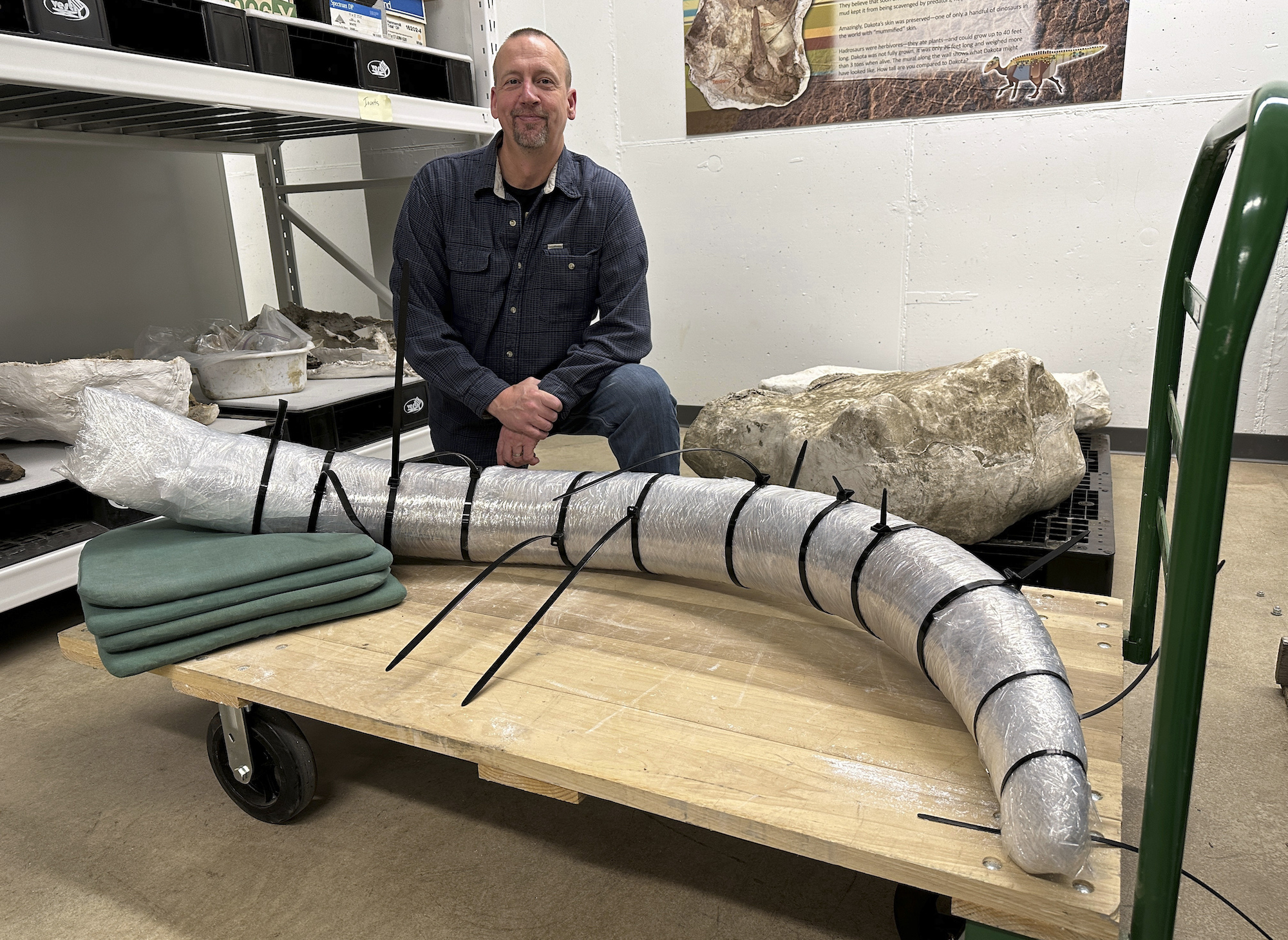Coal miners in North Dakota unearth a mammoth tusk buried for thousands of years | OUT WEST ROUNDUP

NORTH DAKOTA
Coal miners unearth mammoth tusk buried for thousands of years
BISMARCK – The first person to spot it was a shovel operator working the overnight shift, eyeing a glint of white as he scooped up a giant mound of dirt and dropped it into a dump truck.
Later, after the truck driver dumped the load, a dozer driver was ready to flatten the dirt but stopped for a closer look when he, too, spotted that bit of white.
Only then did the miners realize they had unearthed something special: a 7-foot-long mammoth tusk that had been buried for thousands of years.
The miners unearthed the tusk from an old streambed, about 40 feet deep, at the Freedom Mine near Beulah, North Dakota. Owned by North American Coal, the 45,000-acre surface mine produces up to 16 million tons of lignite coal per year.
After spotting the tusk, the crews stopped digging in the area and called in experts, who estimated it to be 10,000 to 100,000 years old.
A subsequent dig at the discovery site found more than 20 bones, including a shoulder blade, ribs, a tooth and parts of hips, but it’s likely to be the most complete mammoth found in North Dakota, where it’s much more common to dig up an isolated mammoth bone, tooth or piece of a tusk.
Mammoths went extinct about 10,000 years ago in what is now North Dakota, according to the Geologic Survey. They were larger than elephants today and were covered in thick wool. Cave paintings dating back 13,000 years depict mammoths.
The mining company plans to donate the bones to the state for educational purposes.
New legislative district ordered for Native American tribes
BISMARCK – A federal judge on Jan. 8 ordered a new joint North Dakota legislative district for two Native American tribes that successfully argued a map created through redistricting in 2021 violated the Voting Rights Act by diluting their voting strength.
U.S. District Court Chief Judge Peter Welte’s decision to adopt and implement a new map comes after a flurry of court filings in the lawsuit since his Nov. 17 ruling that the state’s 2021 redistricting map “prevents Native American voters from having an equal opportunity to elect candidates of their choice.”
The judge had given North Dakota Republican Secretary of State Michael Howe and the GOP-controlled Legislature until Dec. 22 “to adopt a plan to remedy the violation.” The deadline passed with no new map as Howe and lawmakers sought a delay of the judge’s ruling and more time to respond.
The Turtle Mountain Band of Chippewa Indians and the Spirit Lake Tribe brought the lawsuit in early 2022. They alleged the 2021 redistricting map “simultaneously packs Turtle Mountain Band of Chippewa Indians members into one house district, and cracks Spirit Lake Tribe members out of any majority Native house district.”
Days after Welte’s November ruling, Howe announced his plans to appeal, citing a new 8th U.S. Circuit Court of Appeals ruling that private individuals and groups such as the NAACP can’t sue under a critical section of the landmark civil rights law.
NEW MEXICO
Lawsuit alleges FEMA has delayed compensation for wildfire victims
SANTA FE – A new lawsuit has been filed against the Federal Emergency Management Agency, alleging compensation has been delayed for victims of the largest wildfire in New Mexico’s recorded history.
FEMA is responsible for doling out funds to people who suffered losses in the Hermits Peak/Calf Canyon Fire that began as two prescribed burns set by the U.S. Forest Service in January and April 2022 in northern New Mexico.
The blazes combined and burned about 341,000 acres in the mountains east of Santa Fe, destroying hundreds of homes and displacing thousands of residents in rural villages throughout the area.
The federal government set aside nearly $4 billion last year to pay claims related to the wildfire.
FEMA officials said as of last month, the agency had paid $276 million to 880 claimants who suffered losses.
The Santa Fe New Mexican reported on Jan. 3 that the latest lawsuit involving the devastating wildfire was filed by 15 claimants who say FEMA officials misrepresented claim deadlines and has failed to process claims within a required 180-day time frame.
The plaintiffs said FEMA has “unilaterally decided” the 180-day period to notify claimants of a compensation offer starts not when a claim is submitted but after the federal agency has “acknowledged” the claim, which can be as long as five months after it was filed.
FEMA’s New Mexico information center declined to comment on the lawsuit, but it said it had identified a flaw in its reporting system that affected the timeline management of some cases.
OKLAHOMA
Judge rules man imprisoned for decades for murder is innocent
OKLAHOMA CITY – An Oklahoma judge has exonerated a man who spent nearly 50 years in prison for murder, the longest serving inmate to be declared innocent of a crime.
Glynn Simmons, 71, who was released in July after prosecutors agreed that key evidence in his case was not turned over to his defense lawyers, was ruled innocent by Oklahoma County District Judge Amy Palumbo on Dec. 19.
Simmons served 48 years, one month and 18 days since his conviction, making him the longest imprisoned U.S. inmate to be exonerated, according to data kept by The National Registry of Exonerations.
Simmons has maintained his innocence, saying he was in Louisiana at the time of the 1974 slaying of Carolyn Sue Rogers inside an Edmond liquor store.
He and co-defendant Don Roberts were both convicted in 1975 of the murder and initially sentenced to death. Their sentences were reduced to life in prison in 1977 after U.S. Supreme Court rulings related to capital punishment. Roberts was released on parole in 2008.
Palumbo in July ordered a new trial for Simmons after District Attorney Vicki Behenna said prosecutors had failed to turn over evidence in the case, including a police report that showed an eyewitness might have identified other suspects in the case.
The ruling makes Simmons eligible for up to $175,000 in compensation from the state for wrongful conviction and opens the door for a federal lawsuit against Oklahoma City and law enforcement involved in Simmons’ arrest and conviction, defense attorney Joe Norwood.
MONTANA
Arrest warrant issued for man accused of killing thousands of birds, including eagles
BILLINGS – A federal judge issued an arrest warrant on Jan. 8 for a Montana man who failed to show up for an initial court appearance on charges of killing thousands of birds, including bald and golden eagles. A second defendant pleaded not guilty.
The two men, working with others, killed about 3,600 birds on Montana’s Flathead Indian Reservation and elsewhere over a six-year period beginning in 2015, according to a grand jury indictment unsealed last month. The defendants also were accused of selling eagle parts on a black market that has been a long-running problem for U.S. wildlife officials.
Magistrate Judge Kathleen L. DeSoto issued a warrant for Simon Paul, 42, of St. Ignatius, Montana, after he failed to appear at his scheduled arraignment Monday in U.S. District Court in Missoula.
Travis John Branson, 48, of Cusick, Washington, pleaded not guilty and was released pending further proceedings in the case.
The two defendants are charged with a combined 13 counts of unlawful trafficking of bald and golden eagles and one count each of conspiracy and violating wildlife trafficking laws.
Paul and Branson worked with others who were not named in the indictment to hunt and kill the birds, and in at least one instance used a dead deer to lure an eagle that was then shot, according to prosecutors. The men then conspired to sell eagle feathers, tails, wings and other parts for “significant sums of cash,” the indictment said.
They face up to five years in federal prison on each of the conspiracy and wildlife trafficking violations. Trafficking eagles carries a penalty of up to one year in prison for a first offense and two years in prison for each subsequent offense.














